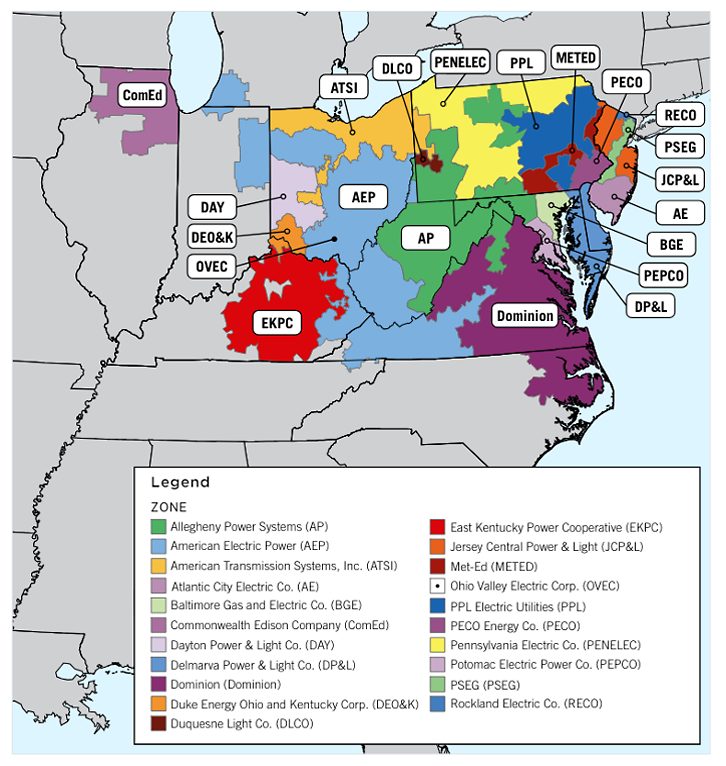Navigating PJM’s Peak Load Contribution: How to Manage Your Energy Spend in PJM
Understanding what charges are on your energy bill and how to best reduce the impact and its implications is crucial for managing your electricity costs effectively. Below, we will delve into what the 5 Coincident Peak (5CP) charges are, its impact on organizations in the PJM area, and strategies for navigating its financial effects.
Understanding Coincident Peak Charges
Coincident peak charges are a way to help pay for the energy generated and transmitted in PJM, the Mid-Atlantic area of the United States. These charges represent the shortfall or surplus between total payments and market revenues expected from electricity consumers. PJM, the local grid operator, must ensure that there is adequate capacity available to meet the system’s peak demand. PJM passes the costs associated with building and maintaining these generation facilities, like peaker plants, off to local utilities and retail suppliers. These costs are then passed on to businesses as either “capacity charges,” or “PLC charges”.
PJM’s coincident peak charges are based on the five highest peak demand hours across the entire PJM region during the year. These hours are typically times of highest electricity usage, often occurring when heating or cooling demand is at its peak. Historically, these PLC days have taken place during the summer months of June through September.

Source: https://www.pjm.com/-/media/about-pjm/pjm-zones.ashx
How are these charges calculated?
PJM calculates these charges based on a facility’s contribution to the system’s overall peak demand during those hours, not based on the amount of energy you used during a given month. The charges are typically assessed based on a customer’s electricity consumption during these peak periods, based on their kW or kWh usage. They are determined by the five highest one-hour system coincident peaks (5CP) on the electric grid. Your average demand during the 5CP comprises your “capacity tag” or Peak Load Contribution (PLC).
Why does it matter?
Coincident peak charges can constitute a significant portion of a business’s electricity bill, particularly for large consumers of electricity. They reflect not just the total energy consumed over a billing period, but also the demand placed on the grid during times of highest stress. These charges can directly impact your business financially, operationally, and environmentally as you look to meet stakeholder demands. Understanding their impact and the steps to manage them is crucial.
How does it impact organizations in PJM
- Financial burden
- Operational challenges
- Competitive disadvantage
- Environmental impact
- Financial planning
For businesses, coincident peak charges can lead to substantial increases in electricity costs, especially if they are unable to manage their energy consumption during peak hours. These charges can significantly impact operational expenses and profitability, particularly for energy-intensive industries like manufacturing, mining, oil & gas, and even cold storage. They also can introduce additional volatility and uncertainty into businesses’ energy expenses. This makes financial planning and budgeting more challenging, as you must account for potential fluctuations in electricity costs driven by these charges.
Managing the 5CP charges can present operational challenges for companies. They may need to adjust production schedules, shift energy-intensive processes to off-peak hours, or invest in energy efficiency measures to reduce peak demand. However, such adjustments may not always be feasible due to production constraints or operational requirements.
Competition is never lacking, and businesses that fail to effectively manage their coincident peak charges may find themselves at a disadvantage compared to peers who are more proactive in energy management. Higher energy costs can erode profit margins and impede investment in other areas of the business. In addition to the financial implications, high coincident peak charges can also have environmental consequences. Increased energy consumption during peak hours may lead to greater reliance on fossil fuel-based generation, contributing to greater greenhouse gas emissions. Effectively managing and understanding how these charges work is critical for success.
Average 5CP charges for PJM customers
Over recent years, the transmission costs have become a larger part of electricity bills which businesses are looking to better manage in the PJM territory. In 2023, the average CP savings to be made range between $17,000 – $160,000 USD per MW-year based on the zone your facility is based. These costs are increasing due to investments and changes to the transmission infrastructure. These figures showcase the importance of understanding and managing the transmission peak charges for businesses.
Strategies for managing peak demand charges
Energy management is increasingly important as energy use is rising, and charges represent a larger portion of an organization’s overall spend. To help mitigate financial impact, there are strategies you can implement with the help of leading curtailment service providers in North America like Rodan Energy. Below are several measures to consider to better manage your overall energy spend:
- Demand Response: Participating in demand response programs allows customers to reduce their electricity usage during peak demand periods. In exchange for reducing your consumption during these times, customers receive incentive payments which can be worth tens of thousands of dollars annually.
- Energy Efficiency: Implementing energy efficiency measures can help reduce overall electricity consumption, thereby lowering 5CP charges. This can include upgrading to more energy-efficient equipment, improving insulation, optimizing HVAC systems, installing LED lighting, and implementing energy management systems to monitor and control energy usage.
- Energy Management Software: Utilizing energy management software and systems can help businesses monitor, analyze, and optimize their energy usage patterns. By identifying opportunities for efficiency improvements and cost savings, businesses can better manage their system peak demand charges and overall electricity costs.
- On-site Solar: Investing in on-site solar can offset electricity consumption from the grid and reduce reliance on electricity subject to these system charges. Customer-sided solar can provide more resilience for your business. Additionally, this can help your organization meet sustainability goals and stakeholder demand.
- Energy Storage: Installing battery energy storage systems (BESS) allows businesses to store electricity during times of low demand and use it during peak periods when peak demand charges are higher. Energy storage systems are one of the most effective ways to help smooth out electricity consumption patterns and reduce reliance on grid electricity. Pairing battery storage and on-site solar can also significantly reduce reliance on the grid as among other system benefits.
- Load Shifting: Shifting non-time-sensitive energy-intensive processes to off-peak times when charges are lower can help minimize electricity costs. This can involve scheduling equipment operation, production processes, and other energy-intensive activities to coincide with off-peak hours.
How to get started reducing costs
Businesses come in all shapes and sizes, which is why understanding the nuances of each approach is crucial to your success. Partnering with Rodan Energy will help your organization maximize its potential while reducing costs and even adding in revenue generating opportunities. Capacity charges are a significant component of electricity bills in PJM, impacting the large energy users.
By understanding how the PLC is calculated and implementing strategies to manage its charges effectively, businesses can navigate PJM’s electricity market with greater confidence and financial success. Rodan will work with your business to understand its needs and capabilities to implement an effective strategy that meets both your financial and operational goals.




